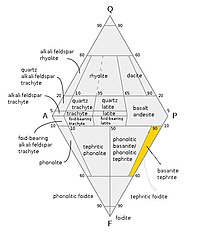Basanite
Igneous rock | |
 |
Basanite (Earth's surface.
Description


Basanite is an aphanitic (fine-grained) igneous rock that is low in silica and enriched in alkali metals. Of its total content of quartz, feldspar, and feldspathoid (
IUGS recommends classification by mineral content whenever possible, volcanic rock can be glassy or so fine-grained that this is impractical, and then the rock is classified chemically using the TAS classification. Basanite then falls into the U1 (basanite-tephrite) field of the TAS diagram. Basanite is again distinguished from tephrite by its normative olivine content and from nephelinite by a normative albite content of over 5% and a normative nepheline content under 20%.[1][2]
The
Chemically, basanites are
silica (42 to 45% SiO2) and high in alkalis
(3 to 5.5% Na2O and K2O) compared to basalt, which typically contains more SiO2, as evident on the diagram used for TAS classification. Nephelinite is yet richer in Na2O plus K2O compared to SiO2.
Occurrences
Livia Drusilla[6]
Basanite appears early in the
During eruption of the Laacher See caldera some 12,900 years ago, the final phase of the eruption, which tapped the deepest part of the magma chamber, produced basanite lapilli mixed with phonolite lapilli.[10] This has been interpreted as fresh magma injected into the magma chamber that may have helped trigger the eruption.[11]
Eruption of basanite and other
shield-building phase.[13]
See also
- Limburgite – type of volcanic rock
References
- S2CID 28548230.
- ^ "Rock Classification Scheme - Vol 1 - Igneous" (PDF). British Geological Survey: Rock Classification Scheme. 1: 1–52. 1999.
- ^ OCLC 951031503.
- ISSN 1525-2027.
- ISBN 0716724383.
- ^ "Livia". Image Collections Digital (NGA Exhibitions, 2008–2009). National Gallery of Art Library. Retrieved 26 March 2021.
- ISBN 9780521880060.
- ^ "Geochemistry and Petrology of a Miocene Trachyte-Basanite Suite from Mt. Tsaratanana, Northern Madagascar". gsa.confex.com. Archived from the original on 2007-05-13. Retrieved 2006-04-05.
- ISBN 3540127569.
- ISBN 9783540436508.
- ^ Schmincke 2003, p. 205.
- ISBN 0824808320.
- ^ Schmincke 2003, pp. 80–81.
External links
Wikimedia Commons has media related to Basanite.
